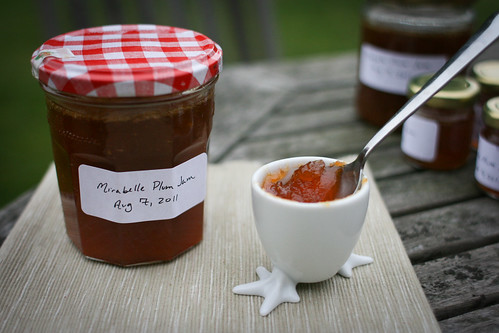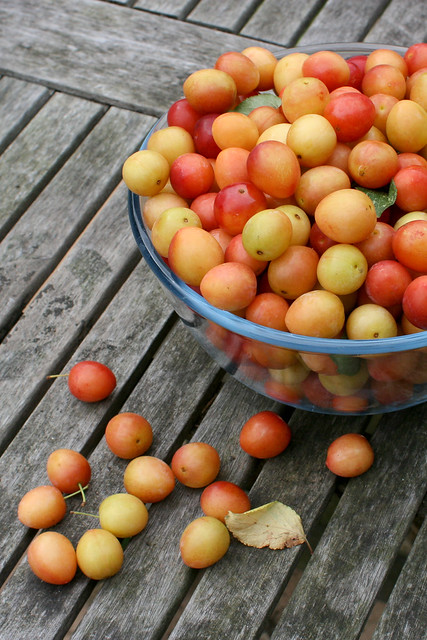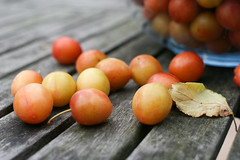A little over a week ago my friend Jason came for a visit. He’s one of my great friends from university and said, “I’m happy having you show me your favorite things even if they aren’t particularly traditional must-sees.” So, amongst other things, I took him for a walk around Bibury and the River Coln, a nice 2-hourish ramble that I love because it’s close, uncomplicated and seems to have it all: rivers, woods, pretty villages, green countryside, hills, sheep and, as we discovered, Mirabelle plums!
We came across the plum tree early on the walk and I insisted we return with a bag and pick as many as we could. And so we did, eating handfuls of plums along the way. I knew right away that I was going to use at least some of the plums for jam.
Jam – like pastry, ice cream, shortbread and apple pie – is a foodI don’t eat very much of, but feel compelled to master its cooking technique. And so, these plums were a great opportunity to practise.
Having never made plum jam, I turned to the experts: my friend and client Rachel Demuth sent me her recipe for damson jam, a recipe that appealed for its simplicity. I also asked Gloria Nicol, author of 100 Jams, Jellies, Preserves & Pickles and all around nice person, for her advice. She sent me this recipe for Blaisdon Plum & Lavender Jam. She macerates the fruit before turning it into jam, arguing that…
…good jam does not come from throwing everything in a pan and boiling like billio. That’s just stewing fruit and you end up with jars of sweet pink mush that somehow remain in the larder for years and that you are unable to ever get rid of. I want to make jam that is so fantastic that you quickly run out and vow you’ll make more next year. I like to macerate the fruit to draw out the juice and the fresh flavours…
I liked this. So I used Gloria’s maceration technique and sugar-to-fruit ratio, but stuck with the basic ingredients that Rachel described. I must confess, I was quite alarmed by the amount of sugar required:
Yep, a lot – but that’s what jam is, and I’m learning there’s a real science to it. First, the sugar is crucial because it reacts with the pectin in the fruit to form a gel and help the jam set. @CarlLegge informs me that “According to McGee [On Food and Cooking ] a pH of 2.8 to 3.4, pectin concentration of 0.5-1.0% & sugar concentration of 60-65% is optimal for setting. The french style conserve has a lower sugar concentration & so is runnier.”
And then there’s the matter of preservation. Danielle Coombs (@restingchef) says, “a concentration of over 60% sugar creates an environment that is hostile to micro-organisms”. Less sugar, and your jam won’t keep as long (explains why my sugar-free raspberry preserves from Bosco del Fracasso went moldy just a few days after I opened it).
Admittedly, I find most jam too sweet for my tastes, and often find that the sugar masks the flavour of the fruit. But since this jam experiment is all about mastering the technique, I didn’t mess around and stuck with Gloria’s recommend sugar to fruit ratio: 1.2kg fruit (or 1kg when stoned) to 750g sugar.
And so I forged ahead, macerating the fruit overnight, then simmered to dissolve the sugar, then once cooled, I removed as many stones as possible, a most cathartic process that I followed until I got bored – I think a few stones in homemade plum jam give it character!
Then, another few hours of maceration, and the final boil. This is when I became slightly disheartened – after 15 minutes of boiling, the jam still hadn’t set (according to the set test). This was when I took a BRIEF break from stirring the jam to check the recipe, during which time the jam started to burn in the pot.
I gasped, then instinct took over. I immediately dumped the jam into a bowl, being careful not to touch anything in the bottom. There were a few black bits in the bowl which I picked out. Then I thought, “screw it”, and jarred the stuff then and there.
The aroma of burnt jam and the feeling of pure idiocy made it difficult to enjoy the taste test. So I put the jam away and decided not to think about it for a couple of days.
Finally, when I could face it again, I had a proper taste: on sourdough toast, one slice with butter, the other with peanut butter (PB&J, an American classic!).
First, the jam set like a charm. I have no idea why it didn’t pass the “set test” but so be it. Second, I loved the texture from the plum skins. Third, and most importantly, the taste was nice. Yes, it was quite sweet, but without a hint of burnt and fine pairing for peanut butter.
True, my preference would be for a tarter jam. The Mirabelles I picked were slightly under-ripe (perfect for jam, so I’m told), and I liked their tart, slightly acidic flavour. To me, this is the flavour of plums, but it got a bit lost beneath the sugar. Still, the result definitely qualifies as “good” and I’m looking forward to testing it on some other folks to see what they think.
The rest of the Mirabelles went either in my stomach, or in the freezer, a stash that should be just enough for that tarte aux mirabelles, when the time comes.
Related links:
- Blaisdon Plum & Lavender Jam – Gloria Nicol’s recipe [laundryetc.co.uk]
- Making Jam and Jelly [homefamily.net]
- The Science of Jam and Jelly Making – very nice two-pager (thanks Carl) [uky.edu]
- On Food and Cooking: The Science and Lore of the Kitchen
by Harold McGee – recommended by numerous people on Twitter and now my latest Amazon order














Your jam is beautiful! I still haven’t perfected a good jam technique, so I brandied my plums from market on Saturday. But I’m going to have to try the maceration technique soon, looks like a charm!
Your narrative is fantastic, and the jam looks divine! I could almost taste the PB&J!
Thanks, you two. Brandied plums – now THAT’s a good idea (and something I’d probably be much more likely to eat than jam). This jam business is weird. I admit, I only have about two jam sessions in my per year – it does take a lot of time and attention. And by the end I’m (sometimes literally) burnt out on the process, if you know what I mean. The maceration was worth the time, though. I didn’t mention this, but once the fruit was soft, I was able to separate some of it from the liquid (Gloria talks about it in her post) and then put them back at the end, so that the final product had more texture. Good stuff.
Could you clarify the ratio of fruit to sugar please.
Is 60% sugar to fruit a good general guide?
Didn’t know that the amount of sugar is critical to keeping quality and to avoid mould.
Thank you
There are so many schools of thought on this and I’m no expert. Many say a 1:1 ratio but this can be tweaked and played with: http://www.theguardian.com/science/blog/2013/oct/03/science-magic-jam-making
Hi, I have stumbled upon your website whilst searching for Mirabelle jam recipes. I love the typography, the aesthetic and you’re creative writing. I think we have a Mirabelle tree in our garden (they seem to be reddish rather than the yellow/golden colour) we have just moved to South west France from the UK and I must admit I have never made jam before so we shall see how this goes!